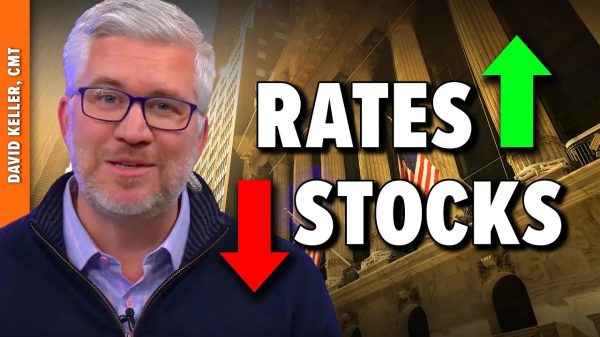Ryan Bourne
In a new policy analysis out today, I make the case for a substantial spending‐cut‐led federal deficit reduction effort. Tomorrow I will outline three economic reasons why deficit reduction is desirable. But today, I just want to take stock of the federal government’s budget realities by outlining five fiscal truths.
1. The United States Today Has a Historically High Budget Deficit
The recorded federal deficit from 2023, at $1.7 trillion (or 6.3 percent of gross domestic product, or GDP), was 23 percent higher than in 2022, but even that was pushed artificially downward by the Congressional Budget Office (CBO) recording the Supreme Court’s cancellation of Biden’s student loan forgiveness plan as a one‐off spending cut. The underlying figure was around $2 trillion, or 7.4 percent of GDP. This is easily the largest deficit recorded outside wars or acute emergencies since the Great Depression of the 1930s.
Figure 1 shows the CBO’s budget deficit projections for the next 10 years. It estimates, on current policy, that annual deficits will grow to $2.6 trillion per year by 2034. This likely understates the scale of red ink. It assumes that large portions of the Tax Cuts and Jobs Act will be allowed to simply expire, that no other large spending programs will be introduced after the next presidential election, and that no unexpected shocks or recessions will hit in the interim. The feds are simply borrowing vast amounts, especially given today’s sanguine macroeconomic conditions.
2. High Deficits Add to a High Existing Debt Burden
As Figure 2 shows, back in 2007, federal debt was projected to fall to around 20 percent of GDP by 2017. It turned out to be almost four times that, at over 76 percent, mainly due to the financial crisis and then a tardy economic recovery.
Since then, federal debt held by the public has jumped again because of pandemic borrowing and ongoing large structural deficits. By 2022, debt hit 96 percent of GDP—the highest level since the aftermath of World War II. This time there is no prospect of a sharp demilitarization that would slash spending nor a political commitment to balanced budgets, as was seen after 1945. In fact, debt is projected to hit its highest‐ever level, 106 percent of GDP, by 2028. High borrowing is thus adding to an already historically high level of debt.
3. On Unchanged Policies, Debt Is Set to Explode Further
Long‐term debt is projected to sharply rise further relative to GDP over the coming decades, primarily due to Social Security and Medicare promises interacting with an aging population. The CBO’s forecasts, based on unchanged policies and fairly optimistic assumptions about interest rates and economic growth, suggest a surge in debt to an unprecedented 166 percent of GDP by 2054 (see Figure 3).
Analysts widely agree that continuing current policies without significant adjustments in tax revenues or spending cuts is unsustainable. Indeed, those who try to model the US economy’s growth prospects are usually forced to just assume that politicians will deliver substantive deficit reduction in the medium term to avoid this scenario, or else their models simply crash.
4. Borrowing Has Become More Expensive with Higher Interest Rates
Government borrowing has become much more expensive as interest rates have risen. In April 2020, the 10‐year Treasury yield was just 0.7 percent. Now it is 4.6 percent, after not rising above 3.1 percent in the 10 years before 2022 (Figure 4). This trend of higher yields is consistent across various Treasury maturity durations—and these interest rates have risen relative to expected inflation. This increase in real borrowing costs is inconvenient, given how much the federal government intends to borrow.
Higher yields have two major effects on federal finances. First, they obviously make it more expensive for the federal government to issue new debt. Second, higher yields make existing debt more expensive because as Treasuries mature, the debt must be refinanced if it has not been paid off. The Committee for a Responsible Federal Budget has calculated that more than half the $26.2 trillion outstanding debt held by the public at the end of 2023 was due to be refinanced within the next three years. “Cheap” borrowing undertaken in the 2010s risks becoming increasingly expensive if interest rates remain higher.
5. The Debt Outlook Is Highly Sensitive to Rising Interest Rates
While it’s unclear whether interest rates will remain elevated or fall back again over the coming years, we know the longer‐term debt outlook is highly sensitive to their level. A 2023 CBO tool revealed that 10‐year Treasury yields at 4.3 percent (rather than their expected 3.8 percent) would add $1.5 trillion to federal borrowing over the next decade (Figure 5).
Moreover, calculations from budget wonk Brian Riedl suggest that if long‐term interest rates were to gradually increase by just 1 percentage point higher than previously expected by 2053, net interest costs could skyrocket to 10.4 percent of GDP, significantly higher than the otherwise‐projected 6.7 percent.
Economists can and do disagree on the urgency of federal budget deficit reduction. But we should all agree on these fiscal truths, which themselves give strong grounds for concern. I expound on these facts, make the case for the broader economic justification for deficit reduction, and present a menu of policy remedies in the full analysis.
























